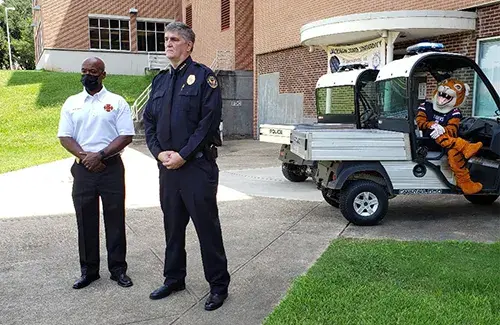Guest post from Rebecca Medina, Director of the Science and Technology Directorate’s (S&T) Office of University Programs.

In recent years, massive storms have become all too common. Several U.S. communities have been ravaged by hurricanes that left major damage and destruction in their wake. There is Hurricane Katrina, deemed one of the costliest hurricanes on record with an approximate toll of $161 billion in damages, and Hurricane Harvey, causing $125 billion worth of destruction. In just the last week, Hurricane Fiona devastated Puerto Rico and slammed our Canadian neighbors, and we are now days away from another named storm, Ian, making landfall in Florida. During the aftermath of these weather events, people in affected areas are often left without electricity, food and clean water, and shelter—which is why we’re working with our university partners to get critical knowledge and resources to local communities and citizens before the storms hit.
To better prepare for natural disasters, the S&T-funded Coastal Resilience Center (CRC)—a Department of Homeland Security Center of Excellence led by the University of North Carolina at Chapel Hill in partnership with Jackson State University (JSU), a Historically Black College and University (HBCU) in Jackson, Mississippi—is reaching out across communities especially vulnerable to natural hazards.
Mississippi has certainly seen its share of storm surges and is especially vulnerable to tornadoes, strong winds, and riverine flooding. There, CRC and JSU are taking a community-based approach to raising awareness about the importance of preparing for disasters and emergencies. Through programs like Community Resilience Engaging Advanced Training and Education (CREATE), JSU provides Mississippians with urgent notifications and information about shelters, evacuations, public safety, and more.
S&T also recently awarded JSU a $469,000 interdisciplinary grant through the Scientific Leadership Award Program for Minority Serving Institutions to prepare undergraduate students to enter graduate programs or careers in emergency management and disaster preparedness, strengthening our first line of defense and fostering the next generation of community planners and leaders. The grant encourages students seeking degrees in more traditional fields like computer science, meteorology, psychology, journalism, and media studies to apply these skills toward more non-traditional disaster resilience efforts.
As a result of the grant, JSU’s CREATE program completed six weather preparedness videos with help from JSU’s Journalism and Media Studies program, which conducted interviews of community members who have been impacted by weather disasters. A weather preparedness drill at JSU’s H.T. Sampson Library, a weather readiness video for JSU’s campus, a weather preparedness drill for JSU’s dormitory and a MadDrama depicting weather readiness are among some of the topics covered in the six videos. The visuals are used by the JSU community to better assist in developing more effective and efficient notifications.

The CREATE program also held virtual weather preparedness town hall meetings with the National Weather Service during the 2021 hurricane season, with additional sessions planned over the next year. They visited local middle and high schools to raise awareness of degree programs related to emergency management, leveraged online and traditional media to disseminate innovative solutions to build resiliency, and are currently assisting the state of Mississippi in creating education, training, and preparedness for weather-related disasters, with a specific emphasis on the needs of underserved communities. Moreover, CREATE’s work will serve as a model for other HBCUs in promoting community resilience and developing the next generation of emergency management professionals.
We asked CRC Lead Principal Investigator Rick Luettich about what the center hopes to achieve through these grassroots outreach and workforce initiatives, which are similarly underway in additional U.S. communities. “The ultimate goal is to empower people with the understanding about what it takes to be more resilient as a whole community. We are providing the tools to empower communities to mitigate the impact of big storms and support official emergency response efforts. But they also have to band together as a community before a storm hits to do everything possible to mitigate the overall impact and we are providing them with the knowledge they need to do that.”
As they say, knowledge is power. Through these CRC efforts, S&T is making sure that the communities that bear the brunt of the destruction of these intense forces of nature are armed with the resources, tools, and knowledge to sustain themselves during the storm and remain resilient and thriving once the dust (and water) settles.
Learn more about S&T’s Preparedness Month Impact and the critical work accomplished by all of S&T's Centers of Excellence. Visit Ready.gov for emergency preparedness resources.
